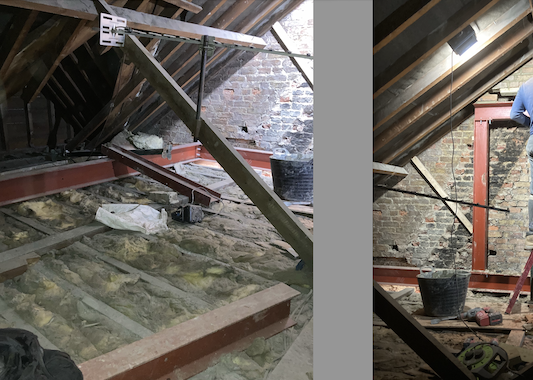| Home |
| Green Building Bible, Fourth Edition |

|
These two books are the perfect starting place to help you get to grips with one of the most vitally important aspects of our society - our homes and living environment. PLEASE NOTE: A download link for Volume 1 will be sent to you by email and Volume 2 will be sent to you by post as a book. |
Vanilla 1.0.3 is a product of Lussumo. More Information: Documentation, Community Support.
Posted By: tonyIf they were mine I would sit them outside the insulation barrier, ie insulate between them and the inside of your home.

Posted By: tonyI would insulate across the ceiling and under the steel beam, insulating between the steel and the ceiling joist with PIR, then up the front of the steel with PIR presuming up to the sloping ceiling then up the slope.
Posted By: tonyThanks for the pic, I think I would have had the chimney down.
Posted By: number_thirty_threePosted By: tonyThanks for the pic, I think I would have had the chimney down.
Removing the chimney itself wasnt possible - the Council do not permit it as it affects the visuals of the roofline from the street (also, practically speaking, my neighbour still uses his fireplaces, and the other half of the chimney is his!). Hence the requirement for an absurd amount of steel ('gallows brackets' are no longer allowed).
Posted By: bhommelsWe are going to end up with the situation that both sides will have steels and whatnot to prop up a ton of bricks for decorative purposes. Madness.FWIW, on a building site near us there are three chimney tops lying in the grass, presumably awaiting use in future houses. I expect the chimneys and pots etc are made of fibreglass or something similar and just bolted on to the roof trusses, but I don't know much about how it all works. Maybe replacing your real chimney with a similar fake would be an answer?
I am going to try my hardest to end up with a minimal amount of steel. I'll ask the structural engineer to look into glulam.
Posted By: djh I expect the chimneys and pots etc are made of fibreglass or something similar and just bolted on to the roof trusses, but I don't know much about how it all works. Maybe replacing your real chimney with a similar fake would be an answer?
Posted By: bhommelsI wasn't thinking about just one side. I would talk to your neighbour and replace the whole lot. They could then remove their steels as well.Posted By: djhI expect the chimneys and pots etc are made of fibreglass or something similar and just bolted on to the roof trusses, but I don't know much about how it all works. Maybe replacing your real chimney with a similar fake would be an answer?
Thanks, I looked at that but removing one side of a mirrored chimney stack on a party wall was advised against even by the structural engineer on my payroll. There is perhaps a chance of discussing with BR folks to see what we can do with fibreglass and matching brick slips. I'm not holding my breath though.
Posted By: djhI wasn't thinking about just one side. I would talk to your neighbour and replace the whole lot. They could then remove their steels as well.
1 to 14 of 14